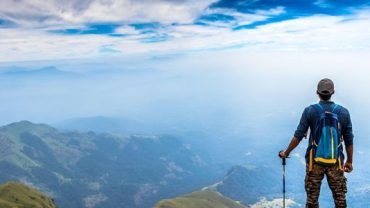Exploring Dudhsagar Safely: Essential Tips for an Unforgettable Trekking Adventure
Nestled amidst the verdant forests of the Western Ghats, Dudhsagar Waterfalls stands as a majestic testament to the raw beauty of nature. Located in the Bhagwan Mahavir Wildlife Sanctuary in Goa, India, Dudhsagar is renowned not only for its breathtaking cascade but also for the exhilarating trekking experience it offers to adventurers. However, trekking to Dudhsagar requires careful planning and preparation to ensure a safe and enjoyable journey through the wilderness. In this guide, we’ll delve into essential safety tips and preparations for trekking to Dudhsagar Waterfalls, ensuring you have an unforgettable and safe adventure.
Introduction to Dudhsagar Trek
Dudhsagar, which translates to “Sea of Milk,” cascades dramatically from a height of approximately 310 meters, making it one of India’s tallest waterfalls. The trek to Dudhsagar is a popular route that begins from Castle Rock or Kulem railway stations, traversing through dense forests, rivers, and scenic landscapes. This trek is not only about witnessing the grandeur of the waterfall but also about immersing oneself in the rich biodiversity of the Western Ghats.
Trekking Routes to Dudhsagar
1. Castle Rock Route
Starting from Castle Rock railway station, this route spans approximately 14 kilometers through dense forests and over streams. Trekkers follow the railway tracks, passing through tunnels and bridges, with occasional glimpses of Dudhsagar Waterfalls in the distance.
2. Kulem Route
Alternatively, trekkers can begin their journey from Kulem railway station, which offers a slightly longer trek of around 11 kilometers. This route also winds through forests, streams, and scenic landscapes, culminating in the awe-inspiring sight of Dudhsagar Waterfalls.
Both routes offer unique experiences, each showcasing the natural beauty and challenges of trekking through the Western Ghats to reach Dudhsagar.
Safety Tips for Dudhsagar Trekking Adventure
1. Plan and Prepare
Before embarking on your trek to Dudhsagar, thorough planning is essential:
- Route Research: Familiarize yourself with the chosen trekking route, including distance, terrain, and landmarks.
- Permits and Permissions: Check if any permits or permissions are required, especially if entering protected areas like wildlife sanctuaries.
- Weather Conditions: Monitor weather forecasts to avoid trekking during heavy rainfall, which can make trails slippery and dangerous.
2. Essential Gear and Clothing
- Footwear: Wear sturdy, comfortable trekking shoes with good grip to navigate varied terrain.
- Clothing: Dress in moisture-wicking, lightweight layers suitable for trekking. Carry a waterproof jacket in case of rain and pack extra socks.
- Backpack: Use a durable backpack to carry essentials such as water bottles, snacks, a first aid kit, sunscreen, insect repellent, and a flashlight or headlamp with extra batteries.
3. Stay Hydrated and Nourished
- Water: Carry at least 2 liters of water per person to stay hydrated throughout the trek.
- Snacks: Pack energy-rich snacks like nuts, dried fruits, and protein bars to maintain energy levels during the hike.
4. Navigation and Trail Awareness
- Maps and Navigation Tools: Carry a detailed map or GPS device to navigate the trekking route confidently.
- Trail Markings: Pay attention to trail markers, signs, or landmarks to stay on the designated path, especially in dense forests or less frequented trails.
5. Wildlife Awareness and Safety
- Respect Wildlife: Dudhsagar region is home to diverse wildlife, including elephants, leopards, and various bird species. Observe from a safe distance and avoid disturbing animals or their habitats.
- Emergency Protocols: Familiarize yourself with emergency protocols, including how to signal for help and basic first aid techniques.
6. Group Size and Communication
- Trekking Partners: Trek with a group or at least one partner for safety and support during the journey.
- Communication Devices: Carry a fully charged mobile phone with emergency contacts programmed. Note that network coverage may be limited in remote areas.
7. Environmental Conservation
- Leave No Trace: Practice Leave No Trace principles by disposing of waste responsibly and carrying out all litter. Minimize impact on the environment to preserve Dudhsagar’s natural beauty for future generations.
Best Time for Dudhsagar Trek
The best time to trek to Dudhsagar Waterfalls is during the post-monsoon season from October to February when the weather is cooler and the waterfall is at its full splendor. Avoid trekking during the monsoon (June to September) due to heavy rainfall and swollen rivers, which can pose safety hazards.
Additional Tips for Dudhsagar Trek
- Train Schedules: Check train schedules and timings for Castle Rock or Kulem stations, as these serve as starting points or endpoints for the trek.
- Local Guidance: Consider hiring a local guide familiar with the terrain and wildlife to enhance safety and navigation.
Conclusion
Trekking to Dudhsagar Waterfalls is a thrilling adventure that rewards trekkers with stunning vistas and a profound connection to nature. By following these safety tips and preparations, you can ensure a memorable and safe journey through the enchanting landscapes of the Western Ghats. Remember to respect the environment, stay prepared for varying trail conditions, and embrace the awe-inspiring beauty of Dudhsagar Waterfalls responsibly. Whether you’re a seasoned trekker or a nature enthusiast, Dudhsagar promises an unforgettable adventure amidst its cascading waters and pristine wilderness.
Prepare well, stay safe, and embark on an expedition to Dudhsagar that leaves you with cherished memories of nature’s grandeur and the thrill of adventure in Goa’s heartland.




Comment (0)